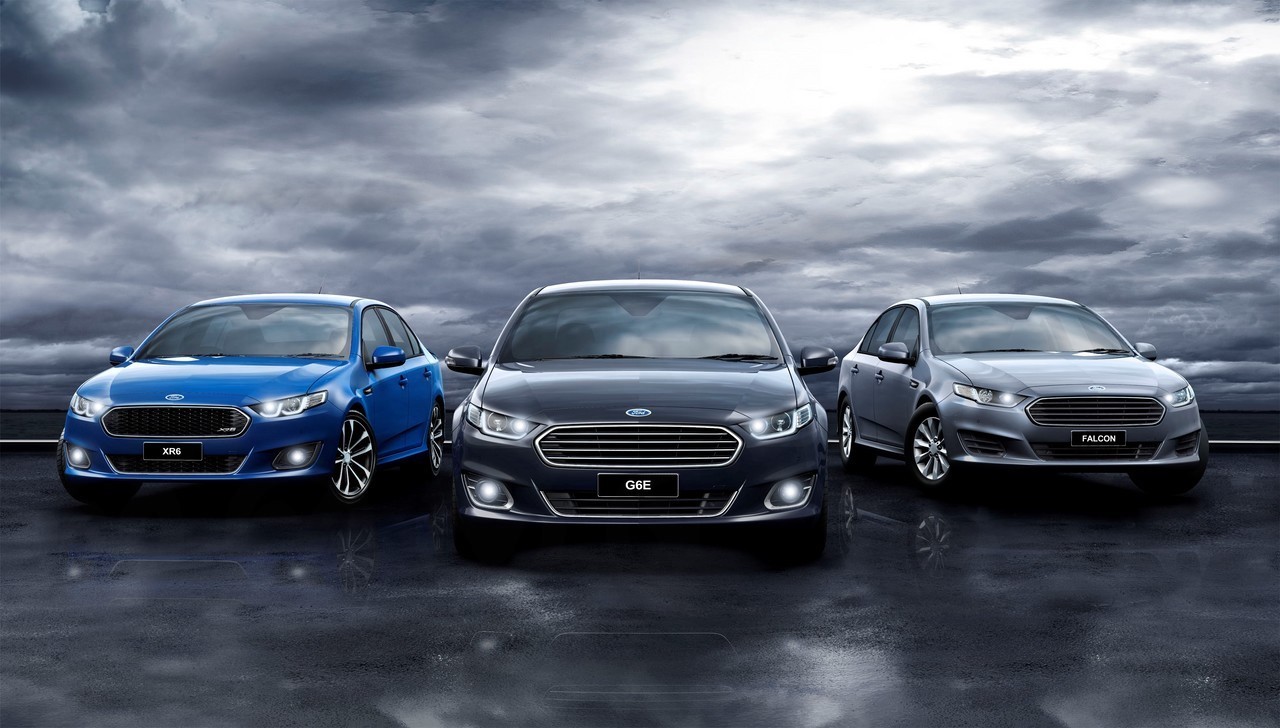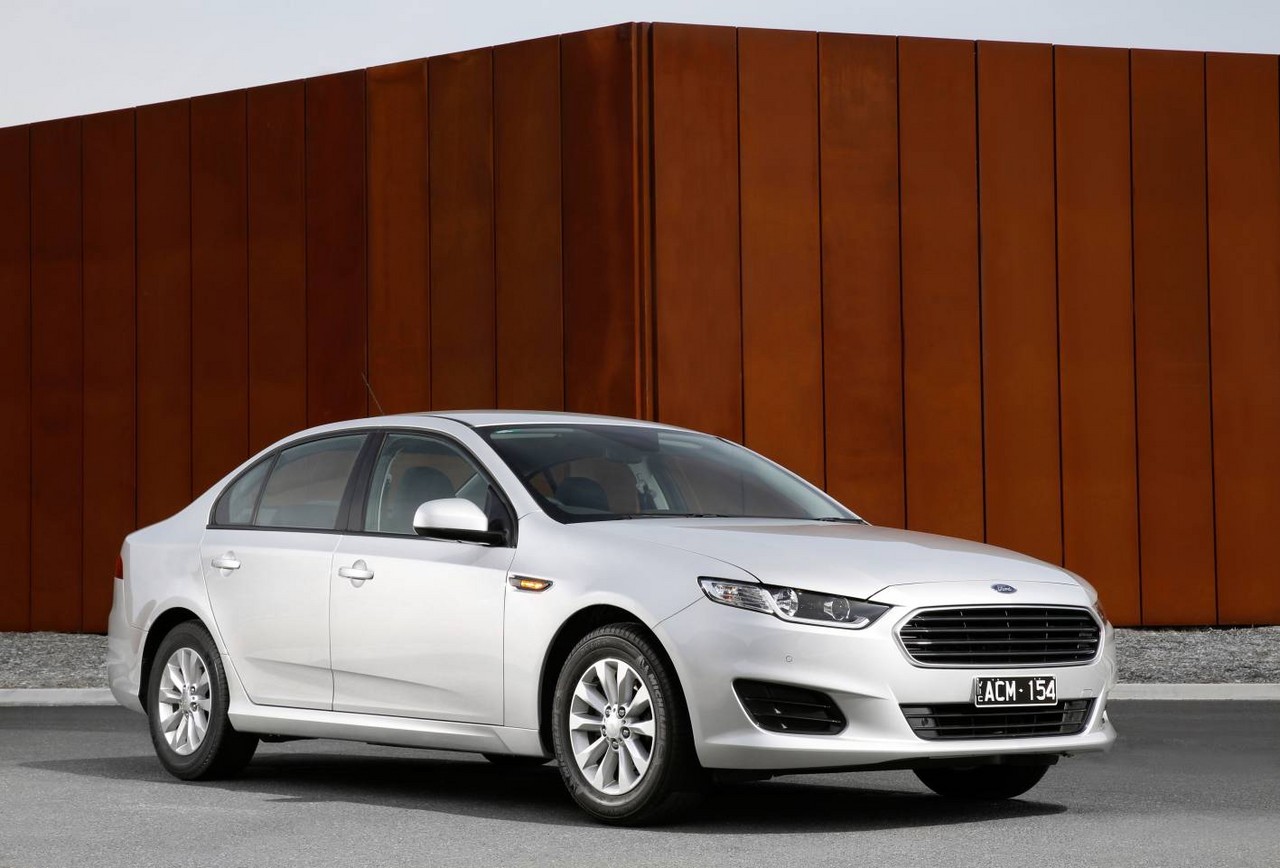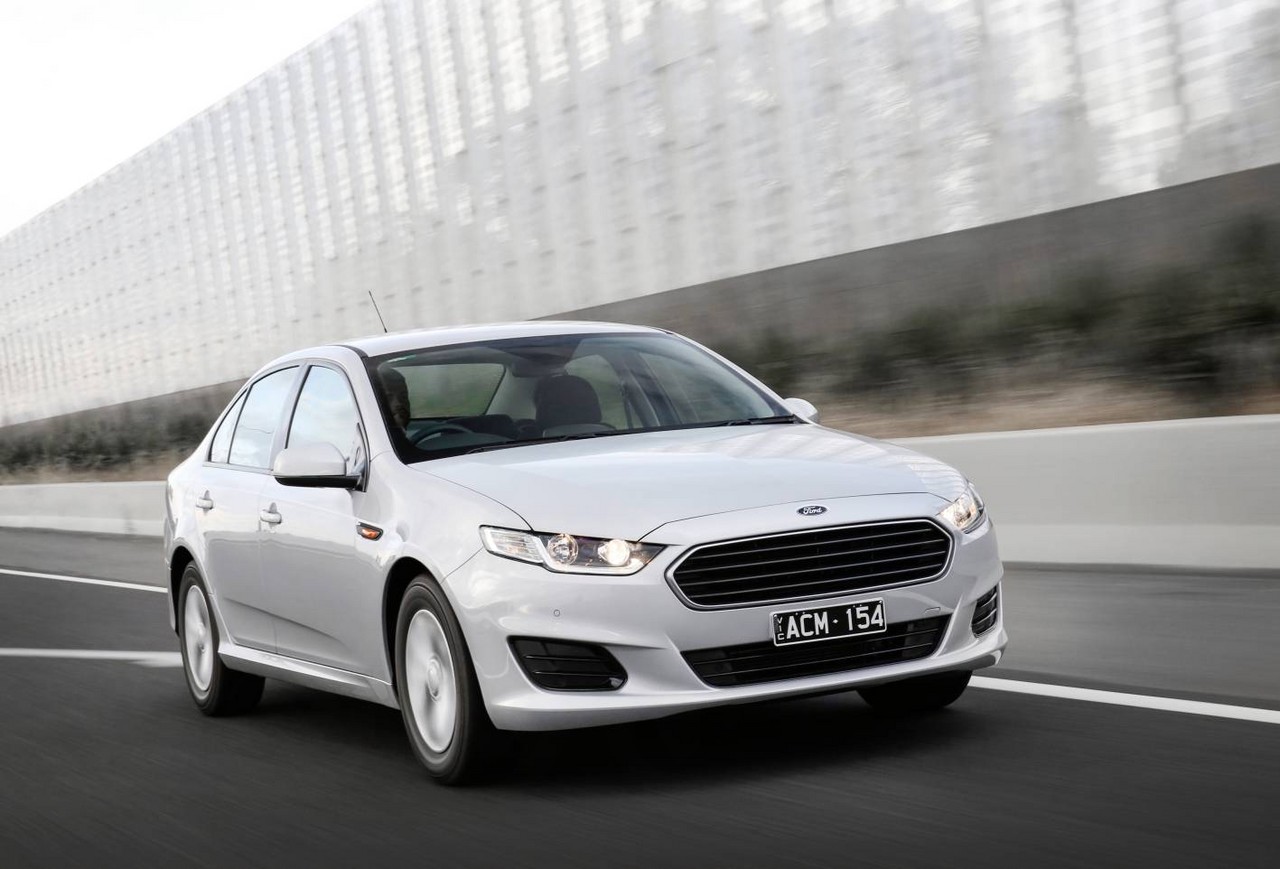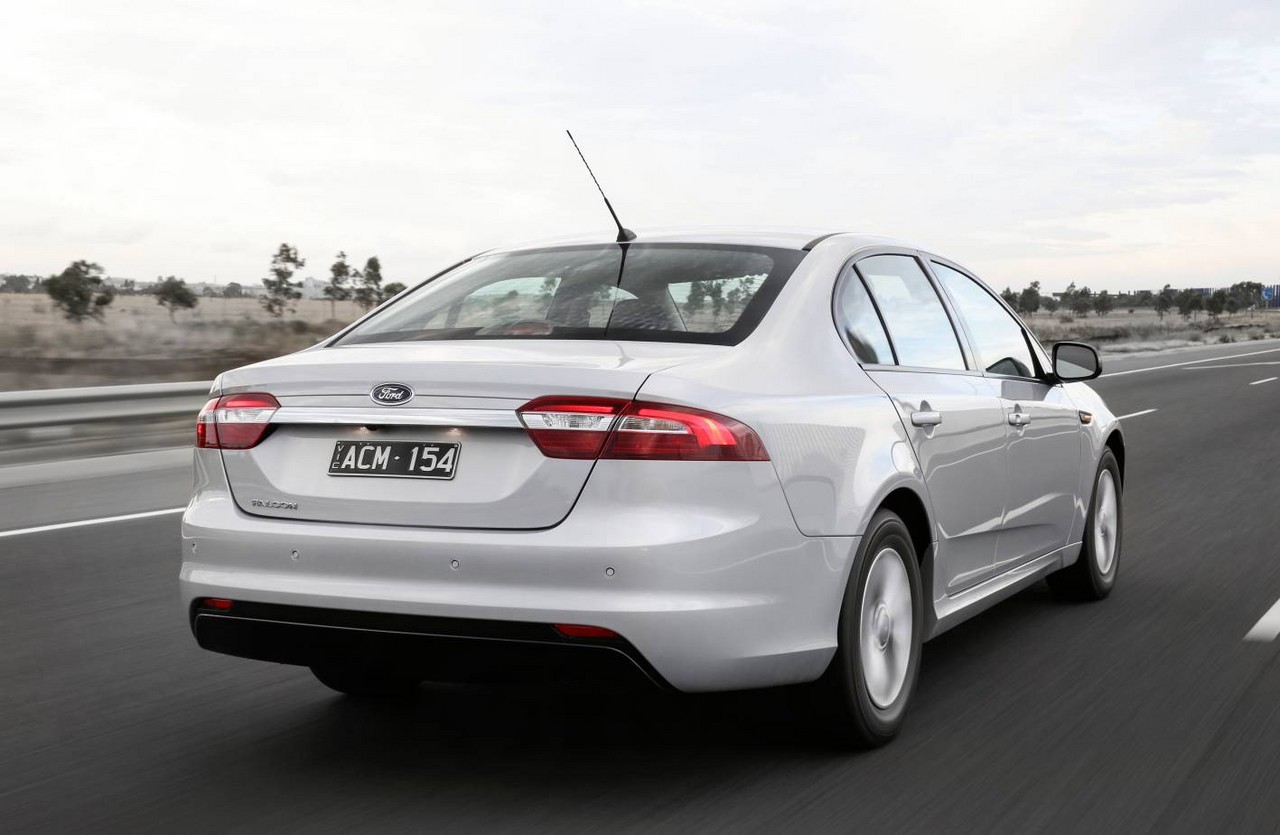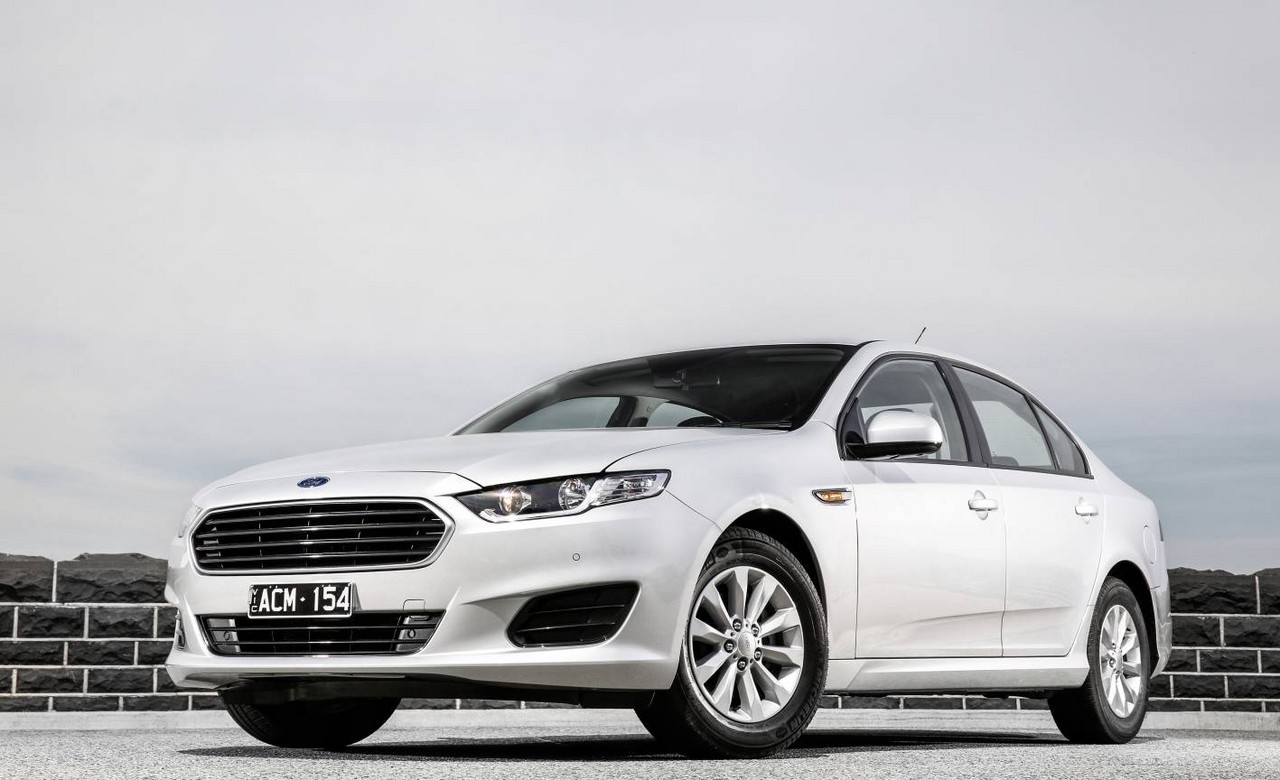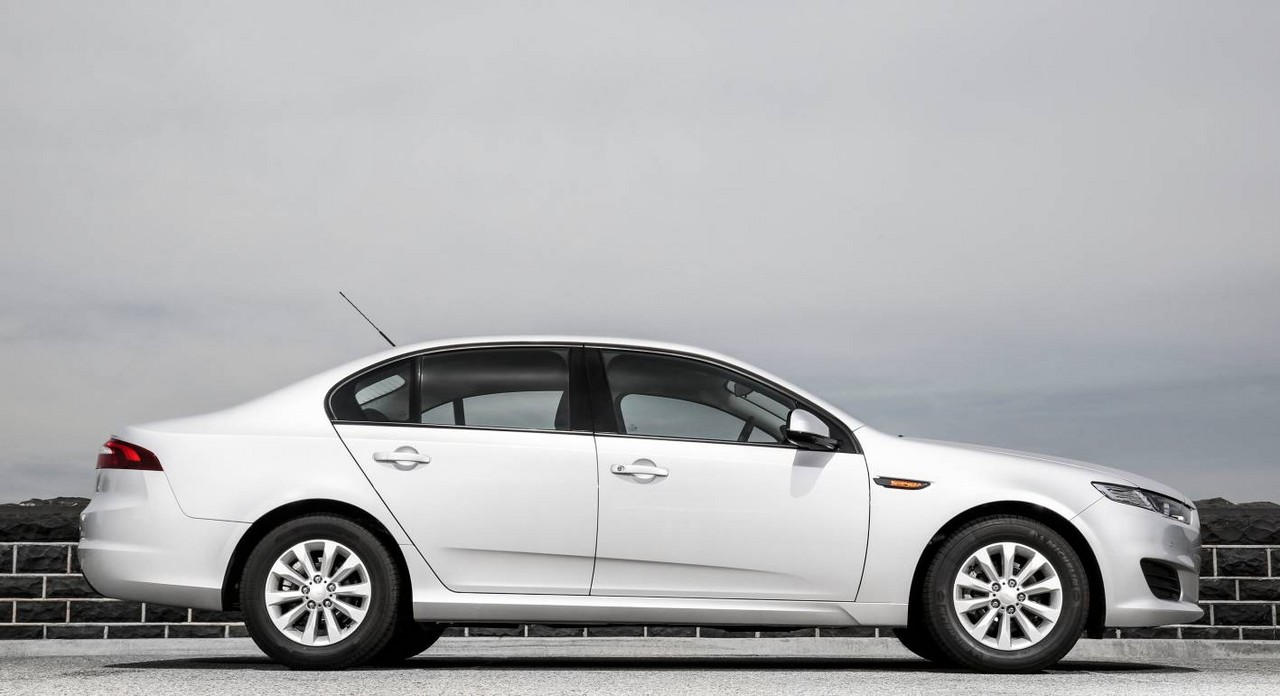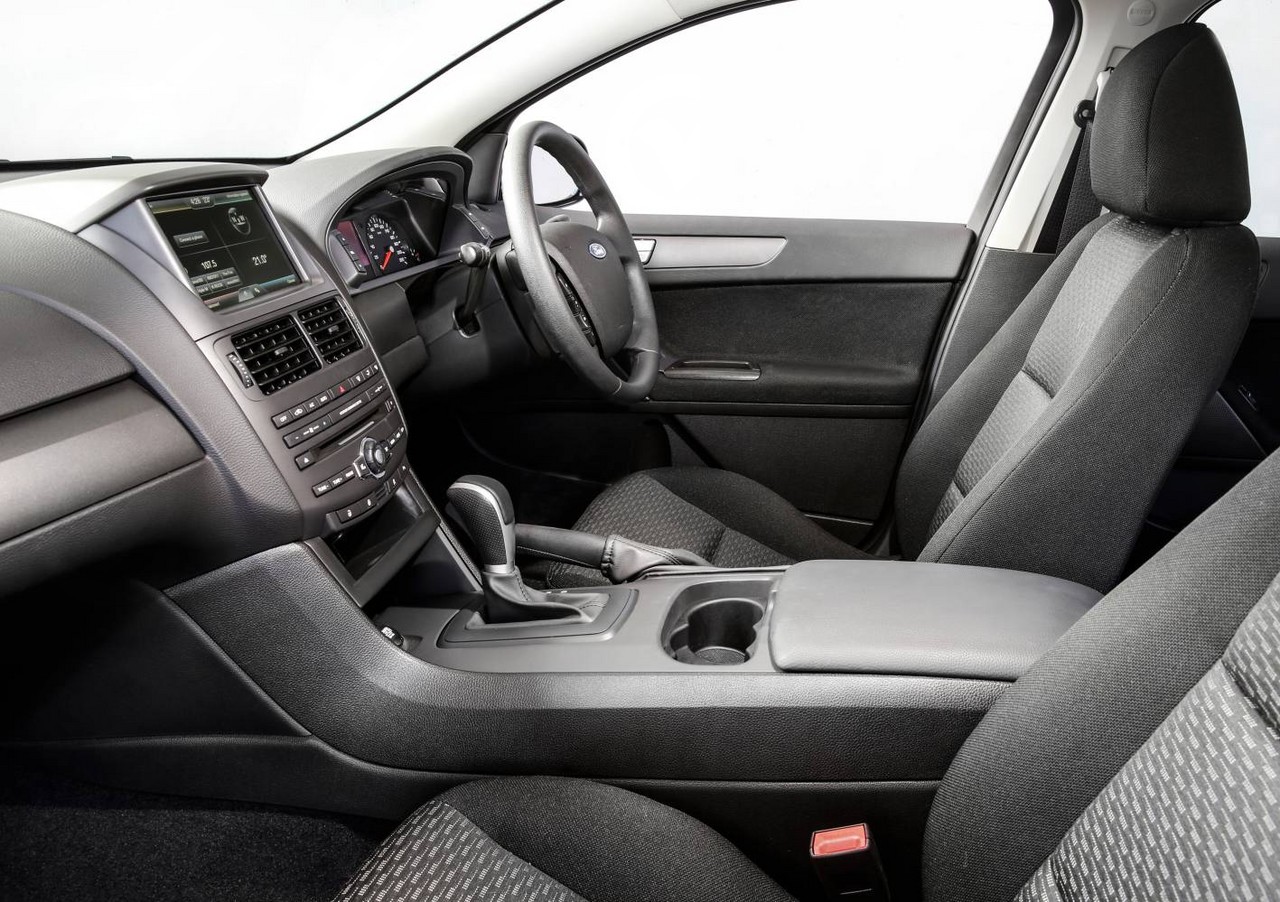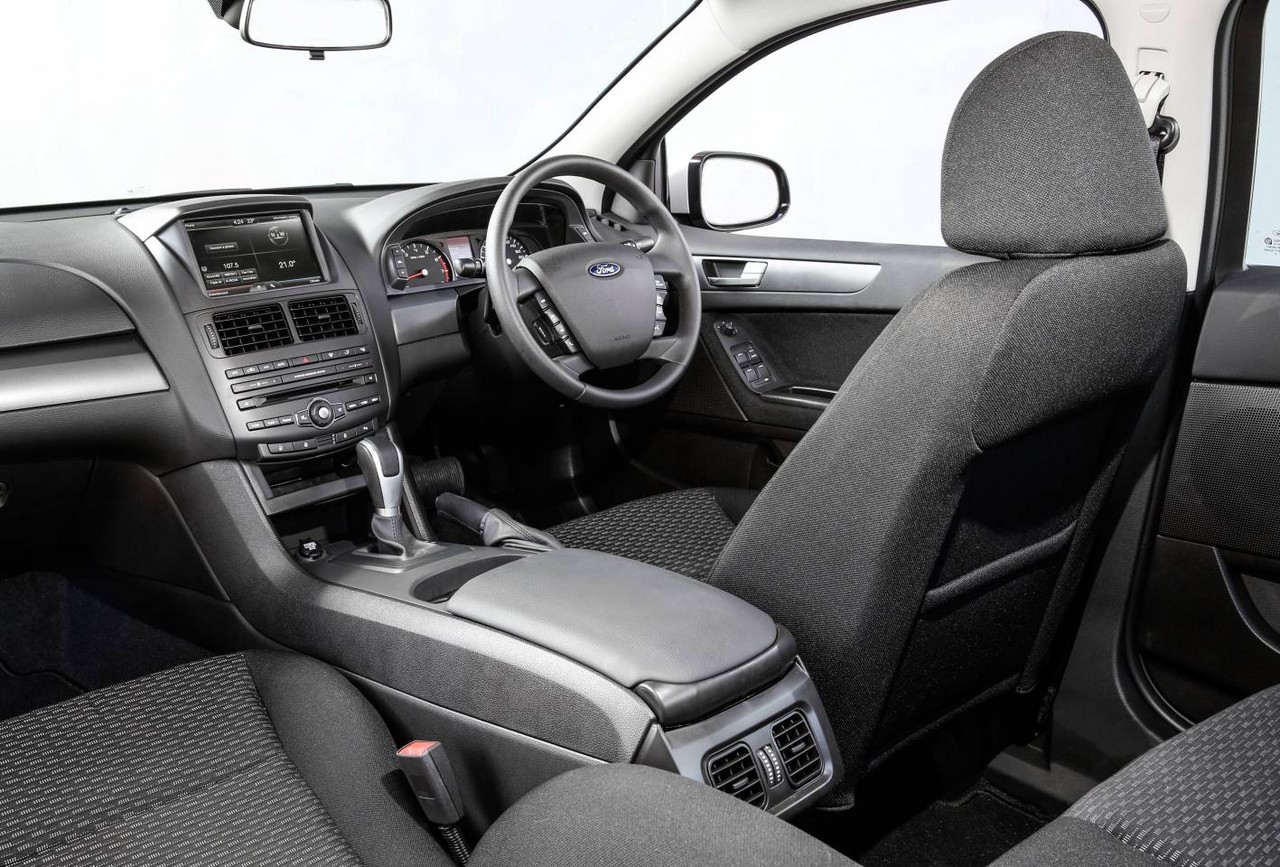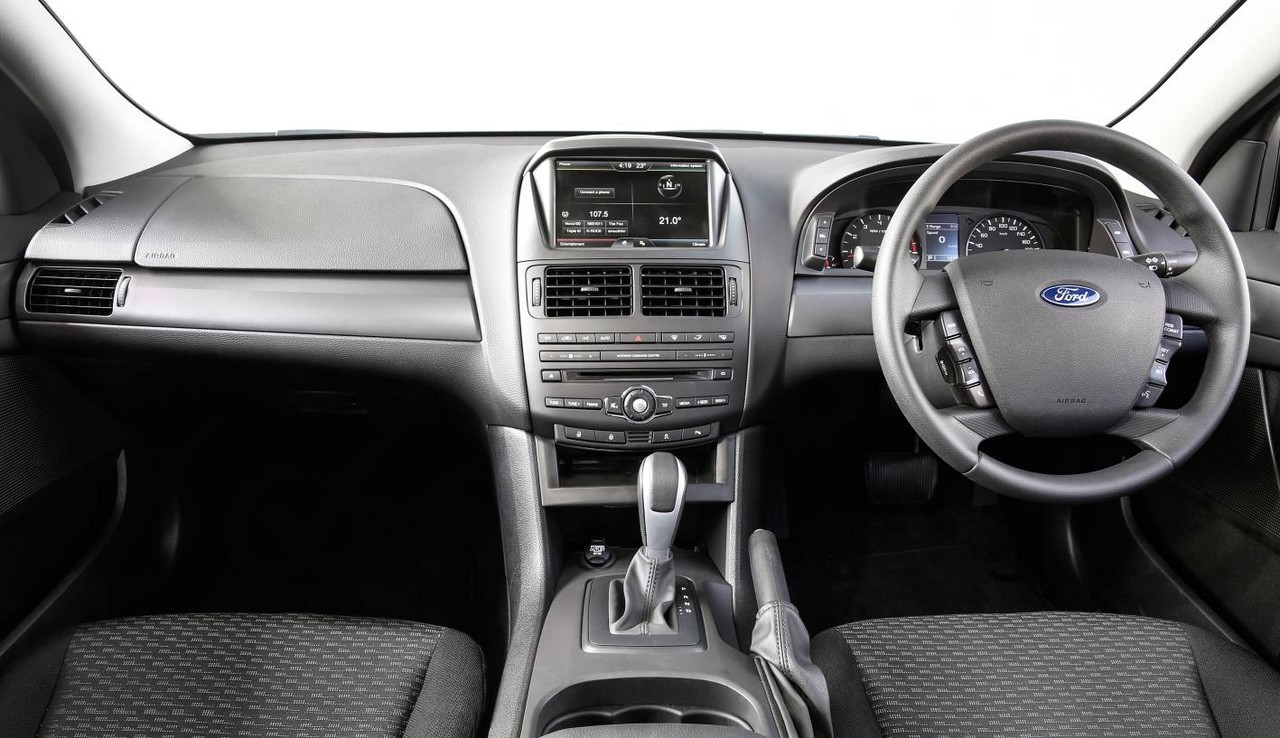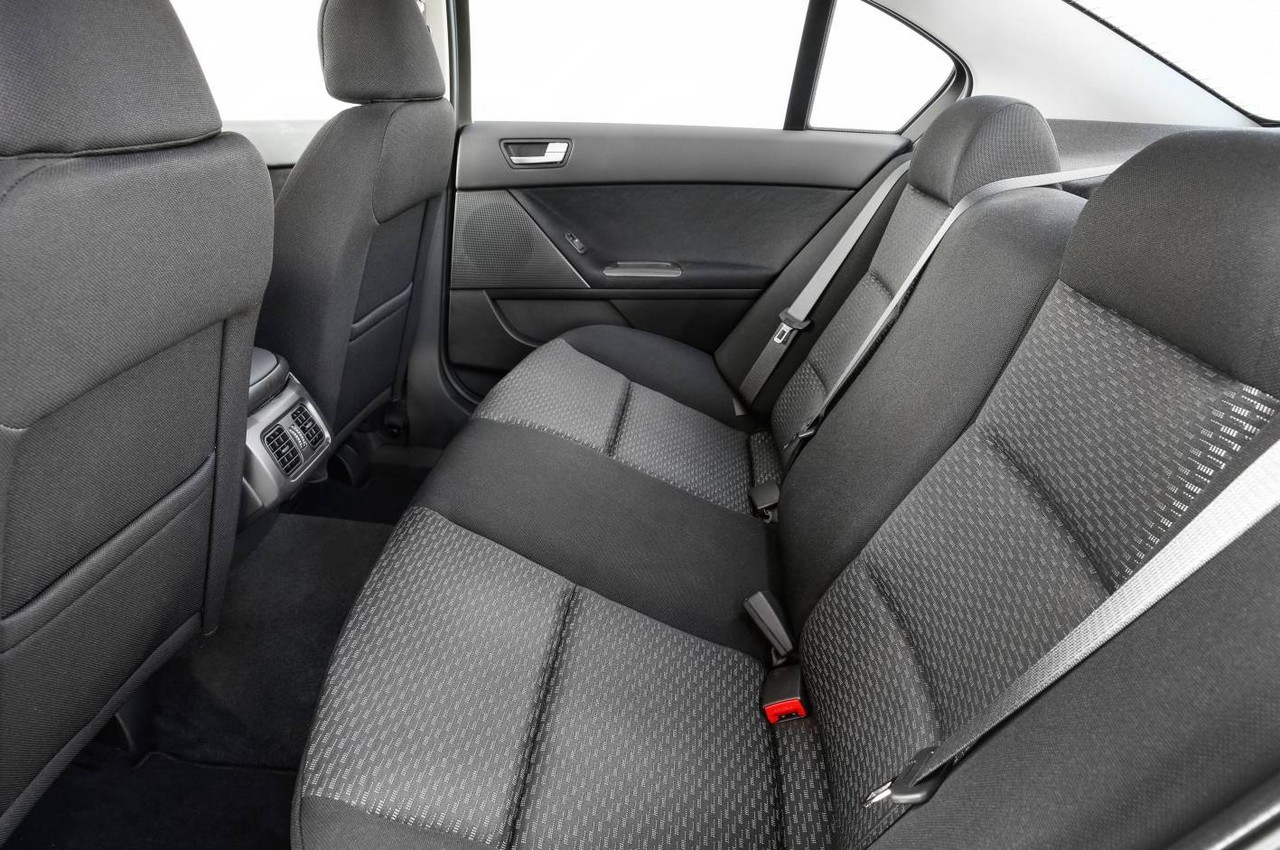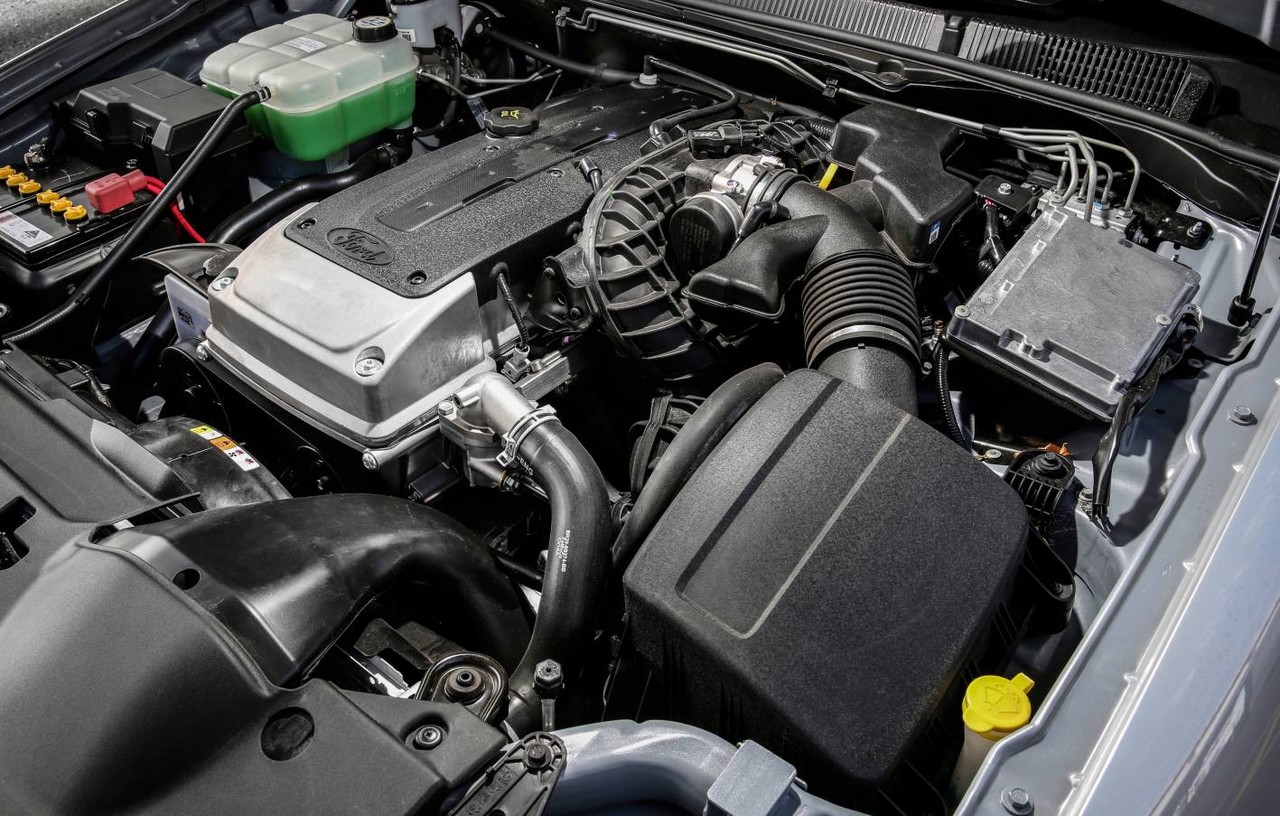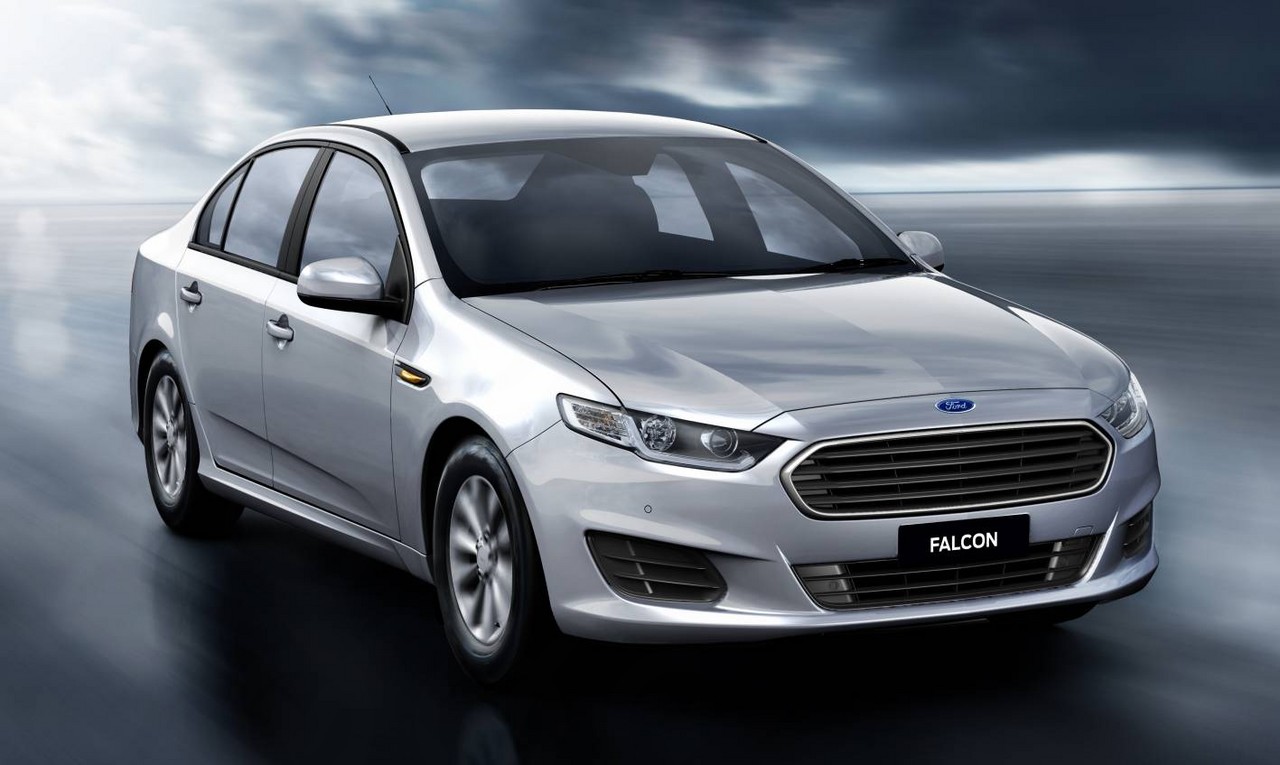
- Impressive ride/handling balance
- Powerful XR6 Turbo and XR8 engines
- Economical EcoBoost engines are a well-kept secret
- Accurate, well-weighted steering provides good feedback
- Spacious interior
- Compromised driving position
- Disappointing interior plastics
- Cast-iron 4.0-litre engines are heavy and not fuel-efficient
- For Falcon XR8, suspension lacks compliance
- ‘Control Blade’ semi-trailing arm rear suspension inferior to VE Commodore-based four-link IRS, particularly for high-powered applications
Overview
Released in November 2014, the Ford FG X Falcon was the final Falcon sedan produced by Ford Australia. Manufactured in Campbellfield, Victoria, the rear-wheel drive Falcon range consisted of standard, XR6, XR6 Turbo, XR8, G6E and G6E Turbo variants (see table below). Ford has announced that production of the FG X Falcon will end in October 2016.
Engines: Barra 195, Barra 270T, EcoLPi, EcoBoost and Boss 335
Of the engines,
- The 4.0-litre Barra 195 inline six-cylinder petrol engine had a cast iron block, a cast aluminium cylinder head, double overhead camshafts (DOHC, simplex chain-driven), dual independent variable camshaft timing, four valves per cylinder, Duratec-style finger followers, a dual resonance inlet manifold, coil-on-plug ignition, electronic throttle control, exhaust gas recirculation, twin knock sensors and a compression ratio of 10.3:1;
- For the Falcon XR6 Turbo, the Barra 270T engine added a Garrett GT3576R turbocharger which had engine oil-lubricated and water-cooled bearings, an air-to-air intercooler, and an electronic single bypass wastegate. The turbocharger was mounted off a cast stainless steel exhaust manifold and provided maximum boost pressure of 7 psi (10 bar), though a transient overboost function enabled the engine to increase boost pressure by up to 10 per cent for several seconds. Compared to the Barra 195 engine , the Barra 270T engine had ‘dished bowl’ shaped pistons, more temperature tolerant exhaust valves and increased fuel pressure (4.0 bar, compared to 2.4 bar). The Barra 270T engine also had two cam timing strategies:
- a primary VCT strategy which balanced maximum power with fuel efficiency, and
- a secondary strategy which optimised turbocharger response for wide open throttle acceleration events; and,
- The 4.0-litre Barra EcoLPi engine was based on the Barra 195 but had liquid-phase LPG injection whereby liquid LPG was injected directly into the intake port. Other changes included a high-pressure fuel pump, rail and injectors, lightweight pistons and a compression ratio of 12.0:1;
- Manufactured in Spain, the 2.0-litre turbocharged ‘EcoBoost’ petrol engine had an aluminium block and cylinder head, high-pressure direct petrol injection (operating at 150 bar), a single turbocharger which provided boost pressure up to 13 psi (0.9 bar), double overhead camshafts (chain-driven), twin independent variable cam timing (Ti-VCT), special oil-cooled pistons with optimised bowls, coil on plug ignition, a balance shaft and a compression ratio of 9.3:1. The EcoBoost models were also 67 kg lighter than their six-cylinder petrol-engined counterparts and the standard EcoBoost had a kerb weight of 1656 kg;
- For the Falcon XR8, the 5.0-litre V8 ‘Boss 335’ Miami V8 engine was originally developed in Australia by Prodrive at a cost of $36 million and based on Ford’s Coyote V8 engine that was introduced in the 2010 Ford Mustang GT. The hand-built Miami V8 engine had an aluminium block and cylinder head, an HTV 1900 supercharger (developed by Harrop Engineering and using Eaton Twin Vortices Series technology) providing maximum boost pressure of 0.4 bar (5.8 psi), a forged steel crankshaft, powder sintered forged connecting rods, double overhead camshafts, variable intake camshaft timing, roller finger followers, four valves per cylinder and a compression ratio of 9.25:1. The Falcon XR8 was also fitted with a bi-modal exhaust system.
| Engine | Model | Trans. | Peak power | Peak torque |
|---|---|---|---|---|
| 2.0-litre EcoBoost turbo petrol I4 | Falcon, Falcon G6E |
6sp auto | 176 kW at 5500 rpm | 353 Nm at 2000 rpm |
| 4.0-litre Barra EcoLPi LPG I6 | Falcon, Falcon G6E, Falcon XR6 |
6sp auto | 198 kW at 5000 rpm | 409 Nm at 3250 rpm |
| 4.0-litre Barra 195 petrol I6 | Falcon, Falcon G6E |
6sp auto | 195 kW at 6000 rpm | 391 Nm at 3250 rpm |
| Falcon XR6 | 6sp man., 6sp auto |
|||
| 4.0-litre Barra 270T turbo petrol I6 | Falcon G6E Turbo | 6sp auto | 270 kW at 5250 rpm | 533 Nm at 2000-4750 rpm |
| Falcon XR6 Turbo | 6sp man., 6sp auto |
|||
| XR6 Sprint | 6sp auto | 325 kW at 6000 rpm (370 kW with o’boost) |
576 Nm at 2750 rpm (650 Nm with o’boost) |
|
| 5.0-litre Miami V8 supercharged petrol V8 | Falcon XR8 | 6sp man., 6sp auto |
335 kW at 5750 rpm | 570 Nm at 2200-5500 rpm |
| XR8 Sprint | 6sp man., 6sp auto |
345 kW at 5750 rpm (400 kW with o’boost) |
575 Nm at 2220-6250 rpm (650 Nm with o’boost) |
ZF and Tremec transmissions
Transmission options consisted of six-speed ZF automatic and Tremec TR6060 manual units. While the standard six-speed ZF 6HP21 automatic transmission was manufactured in China, the high-torque German-built ZF 6HP26 transmissions – for the XR6 Turbo, G6E Turbo and XR8 – were stockpiled since production of these units was to end in late 2014.
Dimensions and suspension
Compared to the Ford FG Falcon , the FG X Falcon was 6 mm shorter (at 4949 mm), 1 mm narrower (1868 mm) and 51 mm taller (1494 mm), while wheelbase length was unchanged (2838 mm). All variants other than the XR8 were fitted with underbody panelling and the drag coefficient was reduced to 0.291 Cd (from 0.312 Cd). Boot capacity for models with petrol engines was 535 litres, though this decreased to 464 litres for the EcoLPi models.
Suspension
The FG X Falcon had ‘Virtual Pivot Control Link’ front suspension (double wishbones with two lower ball joints, an upper A-arm and virtual pivot lower control links). The independent rear suspension (IRS) had three control arms:
- A forged upper control arm;
- A stamped front lower control arm; and,
- A stamped rear lower control arm.
Each control arm had a cross axis ball joint on the wheel assembly end and was attached to the subframe and knuckle. Furthermore, the ‘Control Blade’ was a stamped trailing arm which provided lateral support and acted as a vertical pivot point.
The Falcon XR8’s ‘performance’ suspension was based on the FPV FG GT R-Spec and included:
- Retuned rear dampers and springs;
- A 19 mm rear stabiliser bar;
- Stiffer front upper spring mounts; and,
- Stiffer front upper control arm bushings.
Safety equipment
Standard safety equipment for the Ford FG X Falcon included dual front airbags, front seat-mounted side/thorax airbags, full-length curtain airbags (i.e. for front and rear occupants), electronic stability control, traction control, ABS, electronic brake force distribution, brake assist and front seatbelts with pretensioners and load limiters.
As standard, the FG X Falcon was fitted with Ford’s SYNC2 ‘Emergency Assistance’ function. In the event of an accident in which the airbags deployed or the fuel cut-off switch was activated, Emergency Assistance could deliver a voice message to 000 operators and keep the line open for hands-free communication.
Brakes
The standard braking package for the FG X Falcon consisted of 298 mm by 28 mm vented front brake discs with twin-piston callipers rotors and 303 mm by 16 mm solid rear discs with single piston callipers.
Beyond this,
- The G6E Turbo and XR6 Turbo are understood to have 322 mm by 28 mm vented front brake discs and 328 mm by 26 mm vented rear discs; and,
- The Falcon XR8 is understood to have 355 mm by 32 mm cross-drilled and ventilated front brake discs with four-piston Brembo calipers and 328 mm by 26 mm cross-drilled and ventilated rear discs with single-piston calipers.
ANCAP testing
In ANCAP crash testing , a 2008 Ford FG Falcon XT – without curtain airbags – received a five star adult occupant protection rating with a score of 34.61 out of 37. Based on technical information provided by Ford to ANCAP, this rating was also applied to the FG X Falcon . The FG X Falcon, however, could be expected to provide better occupant protection due to its standard fitment of curtain airbags.
Features: FG X Falcon
Standard features for the FG X Falcon included 16-inch alloy wheels with 215/60 R16 Michelin low-rolling resistance tyres, a four speaker sound system with digital radio (DAB+) and a CD player, SYNC2 connectivity system with an eight-inch colour touch screen, voice control, Bluetooth mobile phone connectivity and audio streaming, auxiliary inputs (3.5 mm/SD card/USB), a WiFi hot spot, climate control air conditioning, a four-way power adjustable driver’s seat (with manual lumbar adjustment), cruise control, automatic headlights, front and rear parking sensors, a reversing camera with fixed and active guidelines, 60/40 split and folding rear seats, a multifunction steering wheel, remote central locking, power windows and mirrors, a height and reach adjustable steering column, trip computer and an immobiliser.
From April 2015 production, the FG X Falcon was fitted with satellite navigation as standard.
Features: Falcon XR6, XR6 Turbo and XR8
Compared to the standard Falcon, the Falcon XR6 was further equipped with 18-inch alloy wheels with 245/40 R18 tyres, a six speaker sound system, cloth sports seats, front fog lights, W-shaped LED daytime running lamps, rain-sensing wipers, a perforated leather wrapped steering wheel, sports instrument cluster gauges with blue backlighting, alloy pedal covers, front scuff plates and rear spoiler.
Beyond this, the Falcon XR6 Turbo and XR8 added 19-inch alloy wheels with 245/35 R19 tyres, satellite navigation system and a limited slip differential. The Falcon XR8 was further distinguished by its 150 watt sound system with nine speakers and a subwoofer, leather sport seat inserts, launch control function and door mirrors with integrated indicators.
The Falcon XR6, XR6 Turbo and XR8 could be identified by their unique front bumpers, sports grilles with accent colour surrounds and slim headlights with L-shaped LED daytime running lights. The Falcon XR8 also had a raised ‘power dome’ bonnet.
Features: Falcon G6E and G6E Turbo
Compared to the standard Falcon, the Falcon G6E was further equipped with 18-inch alloy wheels with 245/40 R18 tyres, a 150 watt sound system with nine speakers and a subwoofer, a satellite navigation system with live traffic updates, dual-zone climate control air conditioning, leather seat inserts, an eight-way power adjustable driver’s seat, front fog lights, L-shaped LED daytime running lights, rain-sensing wipers, a perforated leather wrapped steering wheel, a leather-wrapped hand brake handle, an electrochromatic rear view mirror, memory settings (for the driver’s seat and door mirrors), courtesy lights, door mirrors with integrated indicators and an alarm.
The G6E Turbo was further equipped with 19-inch alloy wheels with 245/35 R19 tyres.
Compared to the standard Falcon, the Falcon G6E and G6E Turbo could be identified by their ‘laser-cut’ slim headlights with technical graphics and finishes, chrome detailing on the outer bezel and bars on the grille, and unique fog lamp bezels.
2016 Falcon XR6 Sprint and XR8 Sprint
The Falcon XR6 Sprint and Falcon XR8 Sprint were released in May 2016. Compared to the XR6 Turbo, changes for the XR6 Sprint included:
- A larger air intake;
- New lower airbox;
- Garrett GT35/76R turbocharger and injectors as per the FPV FG F6 ;
- Larger intercooler; and,
- Unique engine and transmission calibrations.
The XR6 Sprint produced peak outputs of 325 kW at 6000 rpm and 576 Nm at 2750 rpm, though a transient overboost function could increase outputs to 370 kw and 650 Nm for up to 10 seconds. The Falcon XR6 Sprint was solely available with a six-speed automatic transmission.
The Falcon XR8 Sprint produced peak power and torque of 345 kW at 5750 rpm and 575 Nm at 2220-6250 rpm; like the XR6 Sprint, however, a transient overboost function could increase outputs to 400 kW and 650 Nm for up to 10 seconds. It is understood that the power increase for the XR8 Sprint is achieved through changes to the powertrain control module (PCM) that are similar to those in the FPV FG GT-F . For XR8 Sprint models with automatic transmissions, Ford Australia has confirmed that the transmission calibration is shared with the FPV FG GT-F .
The Falcon XR6 Sprint and XR8 Sprint could be identified by their 19-inch black-finished alloy wheels, black headlight bezels, black front fog light surrounds, hockey stick-style stripe decal, black rear deck spoiler and Brembo braking package with gold-painted calipers; the XR8 Sprint also had a black wing mirrors and a ‘Silhouette black’ painted roof.
Inside, features for the Falcon XR6 Sprint and XR8 Sprint were extended to include a 150 watt sound system with nine speakers and subwoofer, ‘Sprint’ seats in leather/lux suede, dual-zone climate control air conditioning, an electrochromatic rear view mirror, unique gear shifter assembly and surround, instrument cluster with ‘Sprint’ logo and ‘Sprint’ scuff plates. For the XR8 Sprint, the manual gear shifter also had a ‘Sprint’ label.
Production of the Falcon XR6 Sprint and XR8 Sprint was limited to 550 and 850 vehicles, respectively, with each model fitted with a build plate on the engine.
Brochure
Related links
